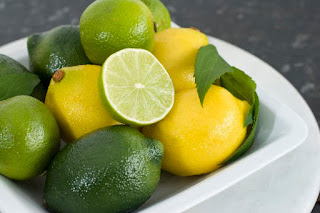HOMOEOPATHIC REMEDY CITRUS LIMON---FOR CANCER
BOTANICAL NAME-—Citrus limon ( L ) Burm.f
COMMON NAMES
Bengali-Baranebu,
Goranebu
English—Lemon
French—Citronnier,
Limonier
German—Limone
Hindi—Baranimbu,
Jambira, Paharikaghzi
Malayalam—Cherunaranga,
Ganapatinarakam
Tamil—Mahanimbu,
Vanabijapura
Telugu—Bijapuram,
Gajanimma, Naradabba
HISTORY
The name Limonum is
derived from the Arabic limun or Limu, which in turn probably comes from the
Sanskrit Nimbuka
It is mentioned in T.F
Allen’s , Encyclopedia of Pure Materia Medica, Vol. 111; J.H Clarke, A Dictionary
of Practical Materia Medica, Vol1,p.532.
OCCURRENCE & DISTRIBUTION
It is a native of northern
India. It is cultivated; grown in the orchards in Uttar Pradesh , Maharashtra,
Tamil Nadu, and Karnataka. Found wild in the north – west regions of India,
ascending 1300 m.
It is also cultivated in
all countries bordering on the Mediterranean , especially in Sicily and
southern Italy, in Spain and Portugal.
DESCRIPTION
 A straggling , bushy ,
small tree, 3-4 m high, with throny branches. Leaves ovate, petiole margined or
winged. Flowers small, white, or pinkish, sweet-scented. Fruit ovoid or
obovoid, externally bright yellow and nearly smooth , about 6-10 cm long and
4-7 cm wide, usually with a nipple-shaped extremity and a dry disc-like nectary
at the base. It consists of about 8-10 carpels and about 8-10 loculi filled
with pulp. The pulp has an agreeable and strongly acidulous taste. Flowers in
April- May and fruits in May-June.
A straggling , bushy ,
small tree, 3-4 m high, with throny branches. Leaves ovate, petiole margined or
winged. Flowers small, white, or pinkish, sweet-scented. Fruit ovoid or
obovoid, externally bright yellow and nearly smooth , about 6-10 cm long and
4-7 cm wide, usually with a nipple-shaped extremity and a dry disc-like nectary
at the base. It consists of about 8-10 carpels and about 8-10 loculi filled
with pulp. The pulp has an agreeable and strongly acidulous taste. Flowers in
April- May and fruits in May-June.
PART USED
Fresh juice- Fresh lemon
yield about 30 percent of juice. It is a
turbid yellowish liquid, translucent , having characteristic pleasant
odor and sour taste. Freely miscible with water and alcohol.It contains not
less than 50 percent w/v of citric acid
CHEMICAL CONSTITUENTS
Limonene, citral, pinene,
camphene,citric acid, phellandene, citronellal, terpinol, octyl aldehyde,
linalyl acetate, geranyl acetate, citroptene.
USES
Citrus limonum is
antidiarrhoeal, antidysenteric, astringent, antiscorbutic , antirheumatic
anti-uricaemic, vitamin rich and refrigerant. The rind is carminative, and
stomachic.
HOMOEOPATHIC USES
Homoeopathic action has
been proved by the occurrence of scurvy from the excessive use of citric acid
when taken for other purposes.
Citrus limonum has
powerful effect on the circulation and on the blood itself. It produces
faintness, a weak pulse, hemorrhages and swellings. Inflammation and painful
enlargement of spleen, dyspnea.Cancer. Relieved the pain of cancer. Lymphoma. Daily
headache. Stiffness in the joints, especially in the fingers, bruised feeling
particularly in the feet. Herpetic eruptions.
THERAPEUTIC USES
Cancer. Colic.
Constipation. Convulsions. Diarrhea. Dropsy. Dysentery. Dyspnea. Eruptions.
Faintness. Headaches. Hemorrhages. Herpes. Rheumatism.Scurvy. Splenitis.
Sunstroke.
POTENCY
IX and higher.




Comments
Post a Comment